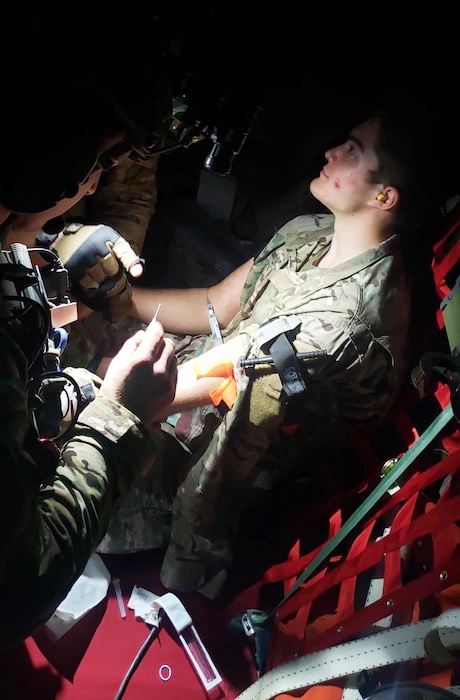PATRICK SPACE FORCE BASE, Fla. (AFNS) —
To find a solution to an identified gap in medical care provided in combat situations, the 920th Rescue Wing’s Aeromedical Staging Squadron developed the Tactical Medical Augmentation Team, an embedded medical team that will bring a new level of patient care directly to the battlefield.
This small, multi-capable, highly skilled, and adaptable team of medical personnel can use the wing’s Personnel Recovery Task Force presentation to move higher levels of medical care further forward to wounded warriors and allow pararescuemen and specialty teams to remain closer to the battlespace.
“This capability increases pararescue’s overall mission effectiveness and serves as a force multiplier for combatant and medical commanders in future conflicts,” said Maj. Alexander Torres, TMAT team officer in charge. “It delivers advanced medical care further forward than previous capabilities.”

The concept takes the previously established models of Air Force pararescue, Critical Care Air Transport Team, U.S. Army Dustoff, British Medical Emergency Response Teams and the previous Tactical Critical Care Evacuation Team missions to build a dynamic medical capability that expands the current capabilities of pararescue. By serving as a medical intermediary between pararescue operators and en-route care system, the TMAT concept uses personnel that are already assigned within the rescue wing and is built specifically to cater to the needs of any rescue mission.
The TMAT, as a proposed embedded military rescue community asset, utilizes the PRTF composition of light-, medium-, and heavy-packages to define capabilities. The total team size of a TMAT-Heavy is comprised of six individuals: one physician, two nurses and three paramedics. A medium team is composed of four members: one physician, one nurse and two paramedics. In the light PRTF model, and for maximum adaptability, the team is composed of two members and can be any combination of physician, nurse and/or paramedic depending on mission requirements.
The TMAT-Heavy can provide prolonged field care for 72-hours, the -medium for 48-hours, and the -light for 24-hours. This provides support options when patients can’t be evacuated and need care until transportation is an option or when geographic challenges prevent immediate transport.
The team physicians will be trained in emergency medicine, critical care, anesthesia, or trauma surgery. The nurses will be emergency or trauma trained with trauma and critical care certifications. The paramedics will have advanced training and certification as flight paramedics, thereby providing them with additional critical care and ventilation skills not seen in standard paramedic training.
The team is capable of being utilized on the wing’s rotor and fixed-wing rescue assets as a force multiplier that does not need to rely on transportation outside of the wing. The PRTFs can utilize the land and water assets such as the wing’s Search and Recovery Tactical Vehicles or inflatable boats. Wherever they can get to patients, not only can they provide care, but they can also get them transported on any asset the PRTF can provide.
“Many patient care teams do not have dedicated platforms to evacuate patients,” said Senior Master Sgt. Matthew Harmon, TMAT non-commissioned officer in charge. “By utilizing organic assets in the PRTF, TMAT is able to rapidly bring a higher level of care further forward to patients allowing pararescue to continue to work tactical problems.”
To validate this concept of medical care, the 920th ASTS created a team of six Airmen that developed a lightweight and adaptable equipment allowance and validated its functionality in various transportation platforms. They then completed training with pararescue Airmen in quarterly unit training assemblies and local-level training events. This evolved into placing TMAT light-, medium-, and heavy-packages into wing-level exercises in Florida, Arizona, New Mexico, California, and Hawaii.
A final test of the TMAT’s ability to integrate with the PRTF came during their use in Exercise Balikatan 22, a multinational, joint forces exercise in the Philippines. There they were able to practice these skills within the Indo-Pacific area of responsibility and included a mass casualty exercise, personnel recovery of a downed pilot, and training Filipino pararescuemen in patient assessment and interoperability in a joint environment.
“We believe that TMAT is a valuable asset to the Air Force rescue community,” said Col. Corey Anderson, 920 ASTS commander. “It provides an irreplaceable medical care option that is organic to the PRTF. I’m proud that this team is getting patients the care they need as soon as possible on the battlefield and allowing the pararescue community to stay where they need to be, which is in the fight.”
By Lt. Col. Ian Phillips, 920th Rescue Wing Public Affairs


Wow, this photo is full of incompetence.
1. Use some universal precautions-gloves
2. Don’t start an IV in an extremity with a TQ
3. To properly apply a CAT the windless needs to be placed into the retaining clip before the time strip is closed.
AF, there’s some great training out there. CONTOMS, FLETC, even your own PJs. If funding is an issue North American Rescue has online training. Bottom line, don’t walk, run away from whoever put this training together.